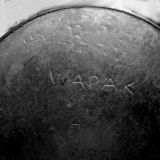"Ghosts In The Machine"
 Occasionally, you'll run across a piece of cast iron that appears to have markings that have all but worn off, even when the rest of the pan seems to be in pretty good shape. Other than by erosion from pitting, the markings cast into iron ware, usually incised, don't wear down appreciably from use. What you're seeing may be "ghost marks".
Occasionally, you'll run across a piece of cast iron that appears to have markings that have all but worn off, even when the rest of the pan seems to be in pretty good shape. Other than by erosion from pitting, the markings cast into iron ware, usually incised, don't wear down appreciably from use. What you're seeing may be "ghost marks".
Ghost marks are not all that uncommon in older cast iron ware. It seems most collectors have a story to tell about at least one crusty pan that emerged from the lye bath or electrolysis tank only to reveal a "ghost".
Ghost marks are what can happen when an existing pattern used to make the molds to create cast iron pieces is modified. If a foundry decided to change its markings, or remove markings altogether in the case of unmarked goods, they often did not go to the trouble and expense of creating new patterns. Instead, the old patterns had the obsolete markings filled in, and new markings added.
Over time and the repeated making of molds, the filler material would erode away somewhat. The result was that faint impressions of the old markings would then be cast into pieces subsequently produced. If quality control didn't catch them, some pieces would end up being shipped out to market. Consumers at the time must not have been all that concerned, especially if they purchased an unmarked skillet only to find a name brand ghost mark on it.
Ghosts may appear in the form of markings of foundries other than the one which cast the piece. One theory is that some foundries may have obtained obsolete patterns from other foundries and modified them. It would have made little sense, however, for a major manufacturer to sell patterns to competitors.
More likely, in most cases, was that actual pans from other foundries were modified, either for use as or from which to create working patterns. We know, from pieces containing ghosts of their own obsolete marks, that several makers updated their existing patterns, so the patterns obviously still held value to them. Griswold "Slant EPU" heat ringed skillets are seen with "ERIE" ghosts under the EPU markings, as are the later smooth bottom slant TM skillets, both indications that Griswold, at least, wrung every last bit of usage from their patterns that they could.
Further supporting the "pan as pattern" theory are observations of ghosted pans being slightly smaller than the originals dimensionally, consistent with the shrinkage of solidifying molten iron. Had original, modified patterns been used, one would expect the copies to be the same dimensions as the original pans.
Sometimes parts of the original markings were even left intact. Pans from Ahrens & Arnold and from Loth's were obviously made using modified Griswold pieces as patterns.
Wapak pieces are often seen which contain Erie ghosts. Some have even been found containing both Erie and Wagner ghosts on the same pan. Look closely at the photo above, and you can see the faint "ERIE" arcing above WAPAK. One theory is that Wapak (and, similarly, other foundries) initially lacked the capital to afford pattern makers, and that circumstance, along with dimensional discrepancies, explains the other makers' ghosts on early Wapak pans.
There are cases, however, in which we can be certain that, if ghost marks exist, they came from modified genuine pattern usage. When Wagner acquired the Sidney Hollowware foundry in 1897, it produced "Sidney" pieces using its own modified patterns. After the company which owned Wagner acquired Griswold in 1957, several Griswold patterns were re-purposed to produce both Wagner and unmarked goods. And, in 1991, Lodge acquired Birmingham Stove & Range Co. patterns-- the Sportsman Grill being a prime example-- when BSR went out of business owing Lodge money for contract work.
Whichever the case, in the matter of ghost marked pans, we can best form a confident opinion about any particular piece only by empirical obervation. If the copy is of the same dimensions as the original, an original pattern can be assumed to have been involved. If the copy is slightly smaller than the original, that, along with other artifacts of the casting process, would indicate that an actual pan was used as a pattern.
Due to the random nature of the manifestation of these "ghosts", there is no documented collectible value to them, other than for what amount various pieces have sold to those who find them a curiosity or an interesting conversation piece.

 Here's a little cast iron "spook house".
Here's a little cast iron "spook house".






